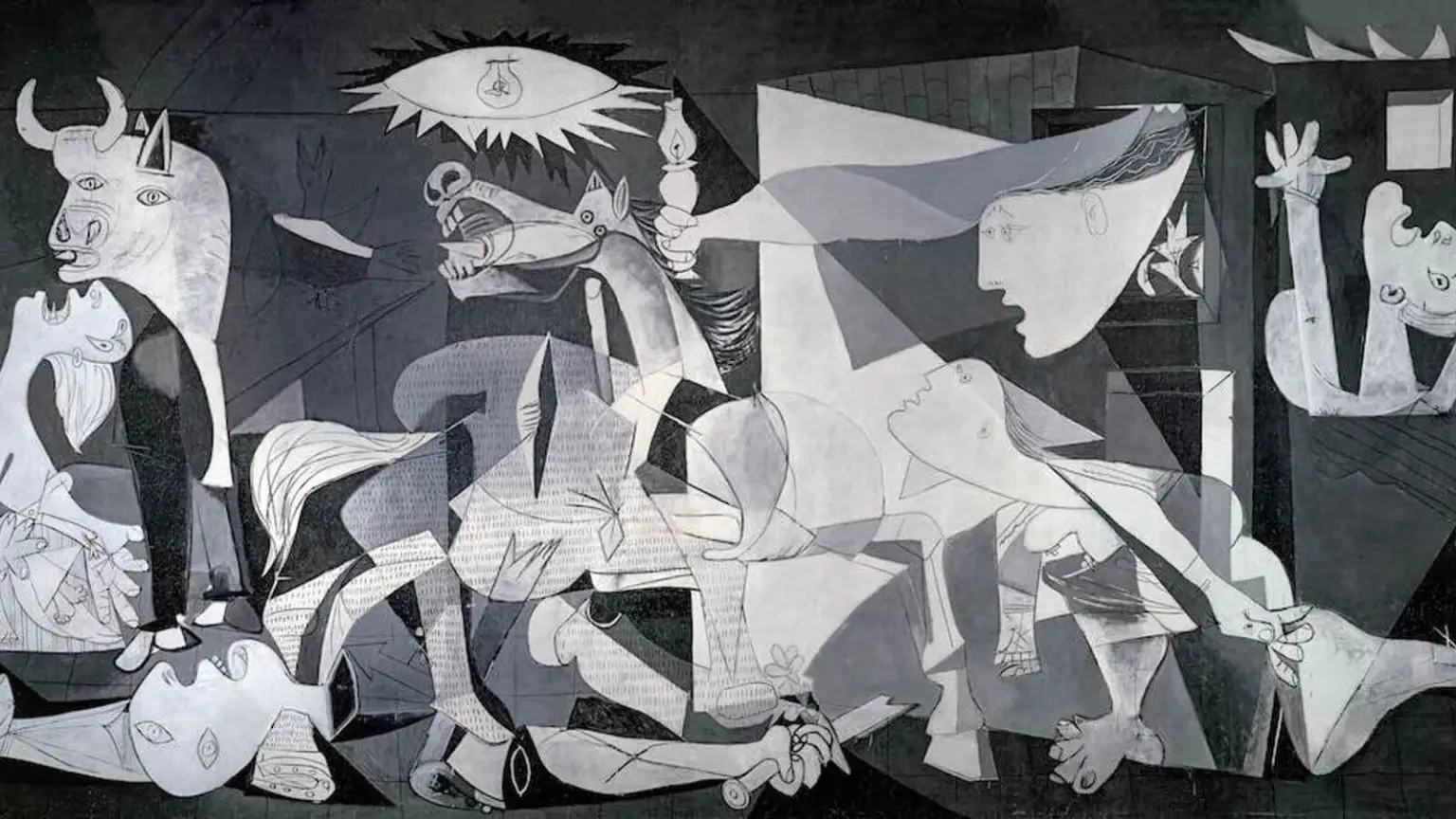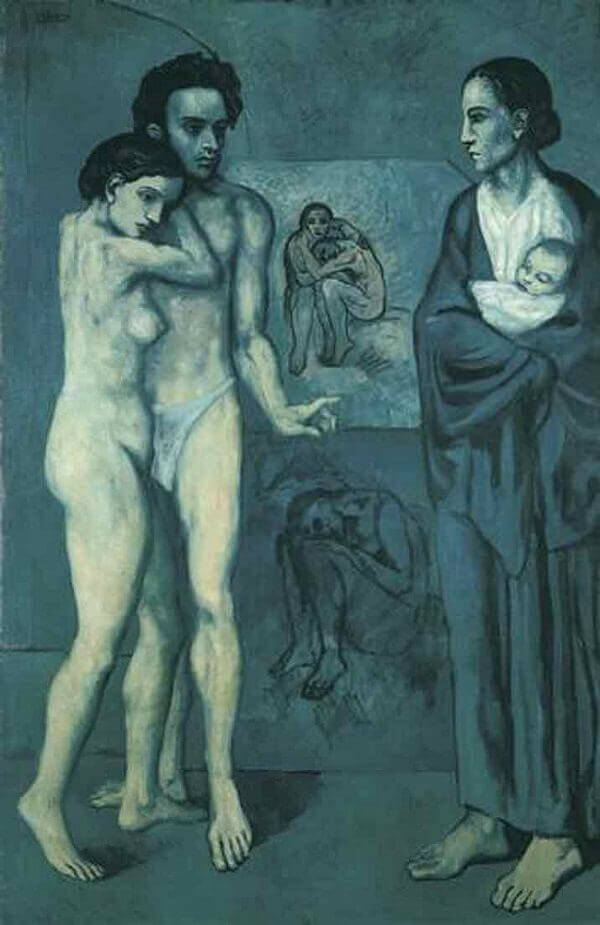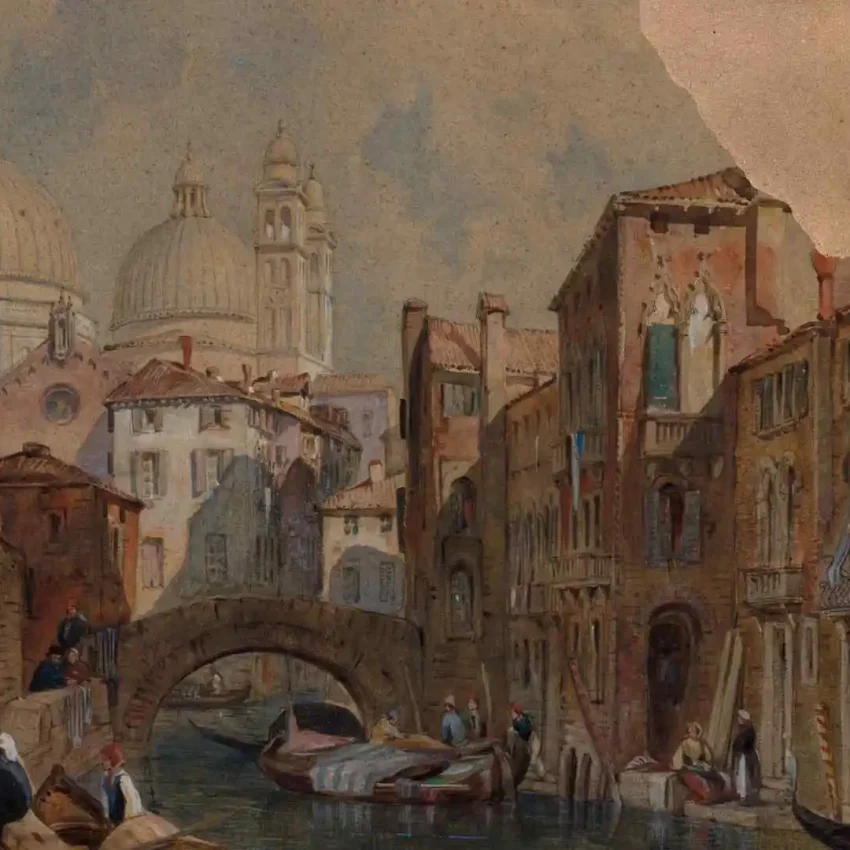10 Most Famous Pablo Picasso Paintings
Famous Artworks Every Art Lover Should Know
In the realm of modern art, few names shine as brightly as that of Pablo Picasso.
A maestro of innovation and a pioneer of artistic expression, Picasso’s life story is woven with the threads of creativity and controversy.
From his early years in Spain to his groundbreaking contributions to the Cubist movement, Picasso’s journey through art was nothing short of revolutionary.
Born in 1881 in Malaga, Spain, Picasso painted with a prodigious talent from a tender age—a harbinger of the
transformative impact he would have on the art world, cementing his status as a seminal Spanish artist.
His foray into different artistic styles and techniques mirrored the tumultuous times he lived in, reflecting both personal turmoil and global events, emblematic of how Picasso produced art in constant dialogue with his surroundings.
From somber Blue Period masterpieces to vibrant explorations in Cubism, each brushstroke told a story—an insight into the kaleidoscopic mind that was Picasso’s creative essence, marking his paintings as milestones in the museum of modern art.
The Old Guitarist 1903 - 1904 & The Blue Period Paintings
The painting “The Old Guitarist,” created between 1903 and 1904, stands as one of Pablo Picasso’s renowned masterpieces.
Executed during a period marked by the tragic suicide of his close friend Casagemas, it reflects Picasso’s heightened empathy towards society’s downtrodden.
Inspired by his own past struggles with poverty, Picasso’s Madrid-era works often depicted the destitute, sick, and unfortunate, showcasing the compassion of this famous Picasso for society’s outcasts.

This particular artwork, reminiscent of the distorted style seen in El Greco’s works, portrays a blind and hunched figure clutching a massive, round guitar.
The shift in colour to a brown hue in this oil painting symbolises a change in mood or circumstance, while the instrument dominates the space around the figure, serving as both a physical and metaphorical barrier.
The profound sense of blindness and poverty emanates from the painting, with Picasso drawing on literary symbolism that equated blindness with heightened inner vision, evident in this oil on canvas masterpiece.
Through “The Old Guitarist,” Picasso invites viewers to contemplate themes of suffering, resilience, and the human condition.
Picasso’s Blue Period (Spanish: Período Azul) spans Pablo Picasso’s artistic output from 1901 to 1904, characterized by predominantly monochromatic blues and blue-greens.
Inspired by Spain and painted in Barcelona and Paris, these melancholic works, featuring subjects like prostitutes and beggars, reflect Picasso’s somber mood.
Influenced by his friend Carles Casagemas’s suicide, Picasso’s choice of colors and subject matter mirrored his emotional turmoil.
Despite initial acclaim, Picasso faced difficulties in selling these works, leading to financial struggles, making his journey a notable narrative in art history.
Themes of loneliness, poverty, and despair dominate his pieces, with notable works including “The Old Guitarist” and “La Vie.”
Picasso's Rose Period

Picasso’s Rose Period, from 1904 to 1906, saw a shift from the somber tones of his Blue Period to vibrant oranges and pinks. Fernande Olivier’s presence influenced this change.
During this time, Picasso explored themes of harlequins and circus performers, refining his formal techniques and prioritizing the painting itself.
“Boy with a Pipe,” painted in 1905 in Montmartre, France, exemplifies this period, showcasing Picasso’s evolving style and creativity.
Les Demoiselles d'Avignon (1907) & CUBISM
Picasso’s Les Demoiselles d’Avignon stands as a pivotal masterpiece that marked the dawn of a new artistic era – Cubism.
Breaking away from traditional forms and perspectives, this painting shook the art world with its fragmented shapes and bold reimagining of reality.
The influence of African masks is evident in the distorted, angular faces of the figures, hinting at Picasso’s exploration of primitive art and cultures.
By deconstructing and reconstructing human forms in an abstract yet coherent manner, Picasso challenged conventions and paved the way for a revolutionary approach to representation in art.
What sets Les Demoiselles d’Avignon apart is not only its formal innovation but also its profound statement on power dynamics and sexuality.
The confrontational gazes of the female figures exude a raw energy in this famous painting, inviting viewers into a complex narrative that delves into themes of desire, vulnerability, and agency.
This radical departure from idealized depictions of women in Western art sparked debates about beauty standards and femininity while pushing boundaries on what could be deemed acceptable subject matter for high art.
Through this painting, Picasso not only redefined aesthetics but also ignited a dialogue on cultural identity and societal norms that continues to resonate with audiences worldwide.

Pablo Picasso and Ma Jolie - 1912

“Ma Jolie,” painted in 1912, stands as one of Picasso’s most celebrated works, notable for its musical undertones and affectionate homage to his lover, Marcelle Humbert.
The title, meaning “My Prettiest Girl” in English, reflects a popular song often heard at the Parisian music halls frequented by Picasso.
In this painting, Picasso employs his distinctive Analytic Cubism technique, characterized by shifting planes and fragmented forms.
While elements hint at the representation of his beloved, Marcelle, the composition defies traditional portraiture.
Instead, viewers encounter abstracted shapes in this famous painting that suggest her figure, such as a triangular form reminiscent of a guitar and four fingers below it.
Additionally, a floating smile and the suggestion of an elbow on the right add to the enigmatic quality of the piece, an oil painting that challenges the viewer’s perception.
Through “Ma Jolie,” Picasso invites viewers to explore themes of love, music, and the complexity of human relationships, transcending conventional portraiture to evoke a sense of mystery and emotional depth.
Guernica (1937): Analysing Picasso’s Anti-War Magnum Opus
In the chaotic turmoil of the Spanish Civil War, Pablo Picasso unveiled a masterpiece that transcended mere artistry to become a symbol of universal anguish and outcry against violence.
Guernica, named after the Basque town devastated by Nazi bombings in 1937, stands as an enduring testament to the horrors of war and human suffering.
Through a monochromatic palette of grays, blacks, and whites, Picasso conveys raw emotion and stark despair without the need for vibrant colors; each brushstroke seems to scream in silent protest against senseless destruction.
What sets Guernica apart from traditional war paintings is its deliberate lack of heroism or glorification of conflict.
Instead, it presents a shattered reality where figures writhe in agony, animals wail in terror, and flames devour hope itself.
The distorted forms and fractured composition mirror the fractured lives left behind by warfare – a deliberate choice by Picasso to depict not just physical devastation but also psychological trauma.
This poignant portrayal has made Guernica more than just a painting; it is a beacon for peace activism and a cautionary reminder of humanity’s capacity for destruction when unchecked by empathy or reason.

The Weeping Woman (1937) & Dora Maar

Picasso’s The Weeping Woman stands as a poignant representation of not just personal anguish, but also universal suffering.
In this masterpiece, the artist delves into the depths of human emotion, laying bare the rawness of pain and sorrow.
The anguished expression on the woman’s face speaks volumes about the inner turmoil that transcends individual experiences to resonate with viewers on a profound level.
This is not merely a portrait; it is a window into the shared complexities of human existence, where grief knows no boundaries.
Through his bold use of colors and fractured forms, Picasso skillfully conveys a sense of shattered tranquility within the composition.
The distorted features of the weeping woman serve as a powerful metaphor for life’s inherent struggles and sorrows that often go unseen beneath outward appearances.
As viewers gaze upon this evocative painting, they are confronted with an undeniable truth: pain is universal, and art has the remarkable ability to transcend language and culture to touch souls in ways words cannot express.
In capturing both personal turmoil and universal suffering, Picasso invites us to confront our own vulnerabilities while recognizing the shared humanity that binds us all together.
During his career, Picasso depicted countless women shedding tears, with his primary muse being his partner, Dora Maar, a renowned photographer entangled in a tumultuous love affair with the artist.
In these portraits, Maar’s visage seems to erupt into a kaleidoscope of vibrant hues.
Exploring Identity and Perception in Girl Before a Mirror (1932)
In Picasso’s enigmatic masterpiece, Girl Before a Mirror, the artist ventures into the intricate realms of identity, self-reflection, and shifting perceptions, marking it as a seminal example of abstract art.
As the dual nature of this portrait unfolds before us, we are confronted with the complexities of how we see ourselves versus how others perceive us, a theme explored in many famous works by Picasso.
The reflective surface becomes a metaphorical stage where personas merge and diverge, inviting contemplation on the fluidity of identity.
Through bold use of color and form, Picasso challenges conventional notions of beauty and provokes viewers to question societal constructs that dictate self-worth, embodying the spirit of avant-garde and abstract art.
The juxtaposition of light and dark tones in Girl Before a Mirror serves as a poignant reminder of the dichotomies inherent in human existence – youth versus age, vitality versus decay.
The mirror not only acts as a physical object but also symbolizes introspection and inner turmoil. In this doubled imagery, one can discern layers of symbolism exploring femininity, mortality, and personal transformation.
By peeling back these symbolic layers within the artwork’s composition, viewers are encouraged to reevaluate their own perceptions about beauty standards and underlying psychological themes that shape our sense of self.

La Vie (1903)

In Picasso’s enigmatic masterpiece, Girl Before a Mirror, the artist ventures into the intricate realms of identity, self-reflection, and shifting perceptions, marking it as a seminal example of abstract art.
As the dual nature of this portrait unfolds before us, we are confronted with the complexities of how we see ourselves versus how others perceive us, a theme explored in many famous works by Picasso.
The reflective surface becomes a metaphorical stage where personas merge and diverge, inviting contemplation on the fluidity of identity.
Through bold use of color and form, Picasso challenges conventional notions of beauty and provokes viewers to question societal constructs that dictate self-worth, embodying the spirit of avant-garde and abstract art.
The juxtaposition of light and dark tones in Girl Before a Mirror serves as a poignant reminder of the dichotomies inherent in human existence – youth versus age, vitality versus decay.
The mirror not only acts as a physical object but also symbolizes introspection and inner turmoil. In this doubled imagery, one can discern layers of symbolism exploring femininity, mortality, and personal transformation.
By peeling back these symbolic layers within the artwork’s composition, viewers are encouraged to reevaluate their own perceptions about beauty standards and underlying psychological themes that shape our sense of self.
Three Musicians (1921)
In 1921, Pablo Picasso unveiled Three Musicians, a vibrant composition that epitomizes his mastery of Cubism while showcasing a playful harmony of form and color.
This monumental work marks a culmination of Picasso’s radical approach to dismantling traditional perspectives and reimagining spatial relationships on canvas.
Through fragmented shapes and interlocking planes, he effortlessly portrays three musicians—each distinct yet unified in their geometric abstraction.
The dynamic interactions between figures in Three Musicians showcase Picasso’s innovative use of multiple viewpoints simultaneously—an essential characteristic of Analytical Cubism.
As each musician occupies their own space yet coexists within a shared composition, Picasso challenges conventional notions of representation while celebrating individual identity within collective unity.
This painting not only encapsulates his technical prowess but also encapsulates the spirit of collaboration that resonated throughout his career—a testament to artistic innovation at its most harmonious intersection.

German Influence in Early Work: Picasso's Bust of a Woman (Fernande)

Picasso’s Bust of a Woman (Fernande) stands as a testament to the profound impact German art had on his early works. Influenced by artists like George Braque and Paul Cézanne, Picasso embraced elements of Cubism and abstraction, forging his unique style that would revolutionize the art world.
The angular lines and fragmented features in this portrait suggest a departure from traditional representational art towards a more conceptual interpretation of the human form, making it one of the most famous examples of Picasso’s innovative approach.
German critic Gustav Schiefler, known for his discerning eye and appreciation for avant-garde movements, was particularly impressed by Picasso’s innovative approach in Bust of a Woman.
Through Schiefler’s lens, we gain insight into how Picasso assimilated German expressionist techniques into his own artistic vocabulary, resulting in dynamic compositions that challenged conventions.
This intersection of cultural influences illustrates Picasso’s ability to synthesize diverse styles and propel them into new realms of creativity, marking the beginning of his transformative journey through modern art.
Portrait Of Gertrude Stein: Embracing Diverse Cultural Threads
Picasso’s Portrait of Gertrude Stein stands as a testament to the artist’s profound connection with diverse cultural influences that shaped his groundbreaking approach to art, heavily influenced by famous works and the abstract art movement.
Gertrude Stein, an American writer and art collector, became not just a subject for Picasso but a muse who symbolized the fusion of various intellectual currents in early 20th-century Paris.
Her patronage extended beyond financial support; it embodied an era where artists like Picasso were deeply entwined with literary figures, philosophers, and avant-garde movements that redefined creativity.
Stein’s influence on Picasso transcended mere portraiture; it sparked a creative dialogue rooted in Cubism and primitivism.
As their friendship blossomed, so did Picasso’s exploration of form and structure in ways that mirrored Stein’s own experimental writing style.
The portrait itself reflects this dynamic exchange – a visual narrative where cultural nuances intertwine, blurring conventional boundaries between subject and artist.
Understanding this symbiotic relationship unveils layers of depth within the painting, unveiling how Picasso wove threads of intellectuality, modernity, and innovation into his iconic work.

Woman In Hat: Fauvist Artwork Techniques in Picasso Paintings

Among Pablo Picasso’s vast collection of masterpieces, Woman in a Hat stands out as a vivid exploration into Fauvist techniques, showcasing his contributions to the musée of modern art.
Created in 1905 during his renowned Rose Period, this painting showcases Picasso’s departure from traditional representational forms towards bold colors and abstract shapes.
The use of vibrant hues and exaggerated brushstrokes not only captures the essence of the subject but also reflects the influence of Fauvism – an avant-garde movement that emphasized emotional expression over realism.
This piece, often overshadowed by his later Cubist works, holds its own significance in Picasso’s artistic journey.
By delving into the world of Fauvism, he challenged conventional norms and pushed boundaries to convey raw emotions through color and form, echoing the dynamism of Boy with a Pipe and other famous works.
Woman in a Hat serves as a bridge between Picasso’s early experimentation with different styles and his revolutionary shift towards Cubism, highlighting his pivotal role in art history.
It exemplifies his ability to absorb diverse influences while maintaining his distinct artistic voice, marking a crucial phase in the evolution of modern artistry.
Conclusion
In the annals of art history, Pablo Picasso stands as one of the most famous and influential figures, renowned for his groundbreaking contributions to modern art.
Through his prolific career, Picasso created some of the world’s most famous artworks, from the iconic Les Demoiselles d’Avignon to the evocative Girl Before a Mirror.
His mastery of diverse styles and techniques, from the geometric shapes of Cubism to the vibrant hues of his Rose Period, solidified his place as one of the world’s most famous artists.
One of Picasso’s most famous paintings, Guernica, painted in response to the devastation of the Spanish Civil War, is virtually synonymous with modern art and remains an enduring symbol of protest against violence.
Picasso’s Blue Period paintings, characterized by their somber tones and introspective subject matter, laid the groundwork for his later explorations in Cubism and abstraction.
Throughout his career, Picasso’s work changed the course of art history, challenging conventions and pushing boundaries with each brushstroke.
From his first works in Barcelona to his later masterpieces, Picasso’s influence on the art world is undeniable. Today, his paintings are celebrated in museums around the globe, from the Art Institute of Chicago to the Musée Picasso in Paris.
In Picasso’s famous Rose Period, exemplified by works like Boy with a Pipe, he experimented with vibrant colors and abstract forms, showcasing his versatility as an artist.
His ability to transcend representational subject matter and delve into the depths of human emotion is what makes Picasso’s work so enduringly captivating.
In Picasso’s Blue Period, he often depicted scenes of poverty and despair, reflecting the hardships of his own life and the world around him.
Yet, even in these melancholic paintings, there is a profound sense of beauty and humanity that resonates with viewers to this day.
As art critics and historians continue to analyze and interpret Picasso’s work, his legacy remains as potent and influential as ever.
Picasso’s paintings continue to inspire and captivate audiences, proving that his impact on the art world is truly unparalleled.
From Les Demoiselles d’Avignon to Guernica, Picasso’s oeuvre is a testament to the power of art to provoke thought, challenge conventions, and inspire change.








